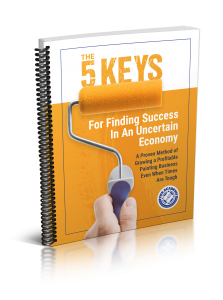Discover How Much Money Should You Earn As a Painting Contractor In Annual Income
How much should you be earning as a painting contractor? It is a very straightforward question. Albert Einstein said something. He said, “If you don’t understand something well enough to explain it simply, you really don’t understand it.” As I watch consultants and painting contractors chit chat in Facebook groups, it just hits me in the face that they don’t really get this. But it’s really straightforward and simple. After you watch this video, share it in Facebook groups. I would love for someone to send me an email and say, “Hey, I posted this in this big Facebook group. These are the comments I got.” I’d just like to know, because to me it’s really, really simple. The first thing I’m going to talk about as we go through this video, and by the time you’re done watching this video, you’ll know exactly how much you should be earning, and if you’re completely off track or you’re on track, or if you had a good understanding or if you don’t, that’s my promise to you.
Here we go. Number one, don’t over complicate this. Doesn’t have to be complicated. If it’s complicated, you don’t get it. Okay? I’m going to teach you exactly how to know what you should be earning, and if you’re on track or off track. Here we go. Can we agree on a few things? There are 2,000 labor hours in a year. 50 weeks times 40 hours is 2,000, even if you’re a doubting Thomas. Can you follow me this far? Okay. 2,000 labor hours. 2,000 labor hours in a year, that means you take off two weeks. Okay? I’m giving you a two week vacation. How much would you earn if you painted by yourself? If you did not own a painting business, and if you did not confuse the hell out of everything, how much would you have earned?
Well, if you’re charging 50 bucks an hour to your clients, then it means you’ve got to estimate accurately using production rates, that means that if you’re in a market where there’s lots of competition, you’ve got to have good, strong customer reactivation and retention system so that you’ve got a strong relationship with your clients so that they understand the value you bring to the table and the risk you reduce because of your professionalism. You got to have a good, persuasive sales process if you’re going to push the envelope on price. Okay. That having been said, I’ve conducted like 2,500 hour long surveys. I know what people are charging all over the United States. I’ve worked with 450 contractors in six different countries. I know better than you what people are charging because of my experience, not because I’m a genius, but because of my experience. $50 an hour is cheap. I mean, that’s kind of what you would charge in lower end markets in Tennessee, Alabama, Louisiana, Georgia, places where the cost of living is low, north Carolina.
I mean, your charge rate doesn’t matter as much as it needs to be relative to the cost of living in the area. I look in places like California, New York city, a lot of metropolitan areas, folks are getting 75, $80 an hour. These are conservative numbers. Even today, these are conservative numbers, very conservative. In fact, two conservative for some markets, but we’re just going to take, if you made 50 bucks an hour charge rate and you came in somewhere on budget, you should make personally 100 grand. The thing that kills me is I’ll talk to people that have three or four painters and they think they’re doing okay, and this has been the best year they’ve ever had, and they’re making 50, $60,000 with three painters. I’m like, “If you just work by yourself.” So, for some reason in our industry, nobody explains this to people. I mean, it is amazing that people don’t understand this or get this or just run simple math in their head.
Now, let’s keep moving. Now, let’s take $60 an hour. Now, listen, “Well, you can’t get it for that in my area, Brandon.” I just get so damn tired of people nitpicking something small and then throwing the whole idea out. Okay, just move the number around to where your area is. All right, buddy? Just move the number around. This is not real hard. Let’s take $60 an hour at a charge rate of 50% of gross profits per painter. What’s that mean? For the most part, what you want to do is take a number like $25 an hour. Let’s say that your average pay rate is $25 an hour. Let’s say you multiply that times 120%, with 20% being labor burden, insurances, taxes, et cetera.
So, that would get your labor burden and pay rate together at about $30 an hour. What you need to charge the client is you double that amount, okay? That provides income to you and it takes care of your overhead. We’re going to talk a little bit about overhead with small businesses here in a moment. So, you hire somebody, you’re going to charge 60 bucks an hour, okay? You are going to run them for 2,000 labor hours a year. This is a W2 example, works the same for subs. Don’t have time to get into all that. This is a short video on how much you should earn. If you ever want to get into the rest of this, we can do it in a diagnostic call, but 50%. That means $60,000. You’d get the same number if you multiplied 2,000 times 30, which is what you clear.
But, okay, that’s $60,000. That should be the gross profit contribution margin of the person that’s painting besides you if you’re in the field. If you’re not, that’s the contribution margin of the dude that’s in the field. But you got to have job costing. You got to have production rates. You got to hit budget. You can’t be charging in your mind $60 an hour, but effectively being at $45 an hour. People don’t do job costing, so they underestimate the hours. They don’t know what their actual rate is they’re getting. They’ve got something in their head they think they’re charging, or they’re doing this goofy guess how long it takes thing, which is never accurate, or they do this goofy $1.50 per square foot or whatever thing they just pulled out of their butt because they don’t understand production rates and they don’t have job costing in place, but this all kind of assumes that. This is very realistic. I see this happen, hundreds and hundreds and hundreds of times.
So, if you got three guys painting, and this is 60 bucks an hour, remember, your income should be 120,000 in gross profits. We’ll talk about something that could make these gross profits net profits in a second. Your first painter clears 60, your second clears 60, and your third clears 60. Well, what’s that equal? That’s $300,000. “Well, Brandon,” well, I can’t help your ability to not do math. If you want to argue with me, that’s fine. I can help the eagles fly higher, but I can’t turn turkeys into eagles. Some people are just too dumb to be helped. This is it. This is the gospel truth. 100% accurate. May God strike me down if it’s not true. That’s how this works.
Now, if you’re a smaller, what I call a word of mouth business, you don’t have much in the way of marketing, et cetera, you’ve been doing this a long time, people just call you, you don’t have a lot of overhead. Maybe you’ve got a little bit of a truck payment, maybe you’ve got some equipment, et cetera. If you’re smaller, your profit is from material markup, which should be about double. If you’re in a painter’s purchasing group, like the one that we offer and operate, which is about 40% lower than any prices you’d get from Sherwin Williams or Benjamin Moore or a lot of other retailers, if you’re in a group, you can just about double your margins or double your prices and still give the paint to the client for 20 to 25% less than if they bought it retail.
So, we take that 15% of material cost, you make a 100% markup, 15% just about goes toward the overhead, takes care of things in a small company. As your company gets bigger and you get out of the field entirely, well, those numbers change a little bit. But these are still pretty consistent. Now, if you’re not painting in the field at all, you should earn 30% cash flow to owner, with 20% of it going to overhead. Remember, we got 50% gross profits. 30% should go in your pocket and 20% should go to overhead. Now, here’s the thing. If you don’t try to build your company on these numbers, and if that’s not your goal, often people just set out to build some kind of painting company and they don’t have any target metrics to hit, and they don’t build sales systems, marketing systems, incentive systems, job costing systems, operation systems, both in the field and the office to hit these goals, so they can’t hit them.
So, because they can’t hit them because their business system sucks, they’re like, “That can’t be done.” Well, no, not with the way you’re doing it and not with the systems you have. But I see this done so regularly and routinely with the proper systems that this is achievable, easily, if you set out to do it, or if you set out to redo your company to hit these metrics. “Well, I don’t agree with you.” I don’t care. You don’t have the experience to disagree with me. I don’t know that there’s another human alive in the United States of America that’s worked with more painting contractors the way that I have to the extent that I have. When you’ve worked with 450, you’ve got a different viewpoint than when you’ve worked with one that’s your own. If you’ve painted 450 houses, you’re going to think of how to paint a house differently than if you’ve only ever painted one.
I’m not smarter. I’m just more experienced. This is true. It’s like Einstein said, “If you can’t explain it simply, you don’t understand it well enough.” So, if this has all been complicated to you, doesn’t make sense, you don’t know where to start, but you know something’s wrong, and I have found that most people understand the truth or know the truth instinctively when they hear it. Now, you may not want to hear the truth, and you may think, “Well, I don’t want to have to do a bunch of work to get my business in order,” fine, but it’s still the truth. This is all still the truth. Those of you who have a little bit of a work ethic and realize that now’s the time to do something different, this is all going to ring true. For those of you that are lazy, this is going to just not make any sense to you.
So, let me explain it, teach it, coach it, and provide you with the done for you tools and resources to get to this earning level. It’s that simple. It is that simple. There are two things I’m going to recommend you do. If you’re watching this video first, if you’ve never gone to paintersacademy.com, paintersacademy.com, and if you have not downloaded our report, the five keys for finding success in an uncertain economy, and boy, has it ever been more uncertain than it is now, very uncertain,, but when you go into an uncertain economy or a recession or anything like that, it doesn’t kill good companies. It kills mediocre companies. It kills bad companies. It’s like if you’re in a boat that’s not very weather worthy and a little bit of a wave comes over, it’s going to capsize your boat. If you’re in a good, seaworthy vessel, you can go through a hurricane in some cases.
So, let me help you get your ship in ship shape so that you can sail through these very stormy waters that we’re presently in. The other thing is for those of you, thousands of you have subscribed to my channel forever, have gotten my emails forever, some of you even attended our painting profit summit, we run the second largest industry event for independent painters in the nation, and we never stopped during all this, just send me an email. Very easy. brandon@paintersacademy.com. We get on the phone, I go through your operation systems, your macro metrics, your paint pricing, your client retention and reactivation systems, your sales time management, staffing, you name it, very detailed, very fast. We cover a lot of ground in a short period of time.
Or call the office, (423) 800-0520. I’ll help you. I’ll help you. That’s it, guys. Very simple. There’s only so many labor hours in a year, you make so much money when you paint yourself, you clear so much money when somebody else paints. Assuming you get pretty darn close to the budget, there’s a lot of money to be made in this business. So, if you are not making the money you should, if you’re not making the money you deserve, it’s probably because you just don’t understand it. I’ll close with this. Almost everybody in the painting industry at some point learned how to brush, learned how to roll, learned how to spray, went through a probably three year apprenticeship. Now, it might have been formal, it might have been informal. But there’s a period in your professional life as a trades person where you learn how to use the tools of the trade.
But here’s this strange thing that happens. People go into business for themselves, and they’ve just become like a glorified crew leader that is now forced to do sales and maybe forced to do a little bit of marketing and forced to do a little bit of management. That’s as far as they ever develop or grow. When you become an owner, you’re not a crew leader anymore. You are not a crew leader anymore. Your responsibilities have completely and totally changed. If you don’t learn how to run the business end of the business, and if you’ve never taken a period in your professional life to learn how to do that, that’s what’s killing your earning power, and you owe it to yourself, you owe it to your family,, those who depend upon you, if you’re going to give them a better life, you have to be a better owner. I’d like to help you. I’ve helped hundreds, and I can do it for you too.
That’s all I got, boys and girls. I hope you’ve enjoyed this. If you did, give it a thumbs up, share it somewhere, ask some of your friends to subscribe. Go on over to paintersacademy.com, get that free resource. Call me, email me if I can be of assistance to you. I’m not going anywhere. The years march on, I stay right here. But if you want to go further than you’ve ever been before, pick up the phone, send an email, download that report, let’s get started. Let’s move in the right direction. Brandon Lewis with the Academy for Professional Painting Contractors signing off.
Take care, guys.
The 5 Keys for Success in ANY Economy

Discover the key to unlocking the hidden income potential in your painting business.
Hear What Other Members are Saying:

Jim and Lorraine
“Our first campaign reached $60,041.98! That's a huge percentage of our annual sales! You don't pick the peach orchard just one time. Different peaches ripen every day. Thanks for encouraging us to keep after it!”

Eric
“15 requests for quotes and closed and/or completed $23,000 of work and I still have a few more to do. Conservatively this campaign will net $25,000 in found money in the first 45 days! Thanks Brandon!”

Torlando
“This year has been the biggest year of growth for us. We're double where we were last year. I realized the real money in this business is in the marketing of the services - not the doing of the services.”
The 5 Keys for Success in ANY Economy
Discover the key to unlocking the hidden income potential in your painting business.
